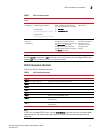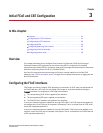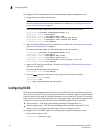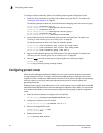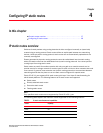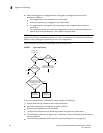Dell Converged Enhanced Ethernet Administrator’s Guide 25
53-1002116-01
Configuring Spanning Tree Protocol
3
2. Activate the protocol.
switch(conf-lldp)#no disable
3. Activate the TLV formats using the advertise command in Protocol LLDP Configuration Mode.
switch(conf-lldp)#advertise dcbx-fcoe-app-tlv
switch(conf-lldp)#advertise dcbx-fcoe-logical-link-tlv
4. Enter the copy command to save the running-config file to the startup-config file.
switch(conf-lldp)#exit
switch(config)#end
switch#copy running-config startup-config
Configuring Spanning Tree Protocol
Spanning Tree Protocol is a mechanism to detect and avoid loops in Ethernet networks by
establishing a fixed path between all the switches in a LAN. The Dell FCoE hardware supports three
spanning tree variations: Standard Spanning Tree (STP), Rapid Spanning Tree (RSTP), and Multiple
Instance Spanning Tree (MSTP).
It is best practice that an access layer switch does not become the root switch. Changing the bridge
or STP priority helps to ensure that this does not occur. The following example performed from the
CEE CLI configures the switch for RSTP and sets the bridge priority to the highest value ensuring it
will not become the root switch in an existing LAN.
To configure RSTP, perform the following steps in global configuration mode.
1. Configure the switch for RSTP.
switch(config)#protocol spanning-tree rstp
2. Set the bridge priority to the highest value so it does not become the root switch in an existing
LAN.
switch(conf-rstp)#bridge-priority 61440
3. Enter the copy command to save the running-config file to the startup-config file.
switch(conf-rstp)#exit
switch(config)#end
switch#copy running-config startup-config
Configuring VLAN membership
IEEE 802.1q Virtual LANs (VLANs) provide the capability to overlay the physical network with
multiple virtual networks. VLANs allow network traffic isolation into separate virtual networks
reducing the size of administrative and broadcast domains.
A VLAN contains end stations that have a common set of requirements which can be in
independent physical locations. You can group end stations in a VLAN even if they are not physically
located in the same LAN segment. VLANs are typically associated with IP subnets and all the end
stations in a particular IP subnet belong to the same VLAN.
In addition to creating a special VLAN for FCoE traffic, VLAN classifiers are applied to incoming
EtherTypes for FCoE Initiation Protocol (FIP) and FCoE. VLAN classifiers are rules used to
dynamically classify Ethernet frames on an untagged interface to VLANs.



